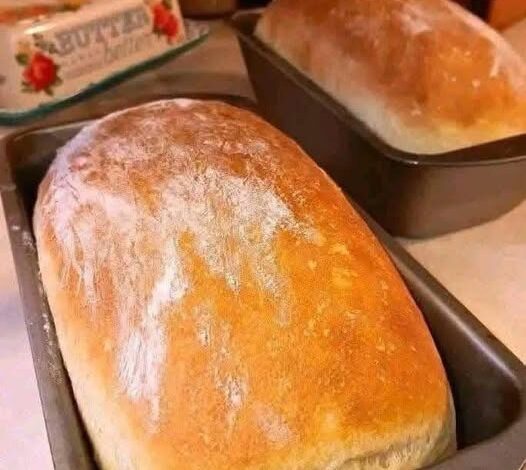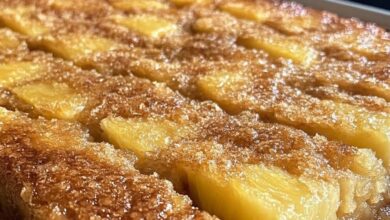The Ultimate Soft and Fluffy Sandwich Bread Recipe

The Ultimate Soft and Fluffy Sandwich Bread Recipe: No Kneading, No Eggs, No Butter!
Making fresh, soft, and delicious sandwich bread at home is easier than ever. With minimal effort and a few basic ingredients, you can create a loaf that’s light, fluffy, and perfect for any meal. Whether you’re a beginner in the kitchen or an experienced baker, this recipe will elevate your sandwich game and have your coworkers asking for more! In this article, we’ll break down the step-by-step process for making sandwich bread without the need for kneading, eggs, or butter. So, roll up your sleeves, and let’s get baking!
Why This Sandwich Bread Recipe is a Game-Changer
This sandwich bread recipe is unique for several reasons. First and foremost, it doesn’t require any kneading. While kneading can be a therapeutic and essential part of some bread recipes, this one simplifies the process by allowing the dough to rise naturally without the need for elbow grease. Secondly, it is entirely egg-free and butter-free, making it a great option for those with dietary restrictions or preferences. And, most importantly, the result is a soft and fluffy loaf that’s perfect for sandwiches, toast, or enjoying with your favorite spread.
Essential Ingredients for Perfect Sandwich Bread
Before diving into the instructions, let’s take a look at the simple ingredients you’ll need for this easy sandwich bread recipe. Don’t worry, there’s no need for any special equipment or exotic ingredients. Just head to your local grocery store and you’ll be good to go!
- 3 ½ cups (440g) all-purpose flour: The backbone of any good bread recipe. All-purpose flour provides the structure and texture needed for a soft loaf.
- 1 ½ cups (360ml) warm water: Warm water helps activate the yeast and gives the dough the perfect consistency.
- 2 teaspoons sugar: Sugar acts as food for the yeast, helping it to grow and produce carbon dioxide, which makes the bread rise.
- 1 ½ teaspoons salt: Salt is essential to bring out the flavors and balance the sweetness of the sugar. It also strengthens the dough’s structure.
- 2 ¼ teaspoons instant yeast: Instant yeast is the key to creating a light, airy loaf. It’s convenient and doesn’t require proofing like active dry yeast.
With these simple ingredients, you’re well on your way to creating a loaf of bread that’s sure to impress.
Step-by-Step Instructions for Making Soft Sandwich Bread
1. Activate the Yeast
Start by combining the warm water, sugar, and yeast in a bowl. Stir the ingredients together until the sugar dissolves. Let the mixture sit for about 5-10 minutes, or until it becomes foamy. This is a critical step because it shows that the yeast is active and ready to work its magic.
2. Combine the Dry Ingredients
While the yeast is activating, gather your all-purpose flour and salt in a separate bowl. Mix them thoroughly to ensure the salt is evenly distributed throughout the flour. This will help prevent any salty pockets from forming in your dough later on.
3. Mix the Wet and Dry Ingredients
Once the yeast mixture is foamy, pour it into the bowl with the flour and salt. Stir everything together until combined. The dough will be sticky, which is perfectly fine. This stickiness indicates that you’re on the right track. Resist the urge to add more flour at this stage; it’s essential for the bread’s texture.
4. Let the Dough Rise
Cover the bowl with a clean kitchen towel or plastic wrap, and let the dough rise in a warm place for about 1 hour. The dough should double in size. This rise is crucial because it helps develop the light, airy texture that makes this bread so perfect for sandwiches.
5. Shape the Dough
Once the dough has risen, it’s time to transfer it to a greased loaf pan. Gently punch down the dough to release any air bubbles and then shape it into a loaf that fits snugly into the pan. Smooth the top of the dough with your hands or a spatula. This shaping step will give your bread the perfect, uniform shape.
6. Let the Dough Rise Again
Cover the loaf pan again and let the dough rise for another 30 minutes. During this second rise, the dough will puff up and fill the pan, ensuring a full, beautiful loaf once it’s baked.
7. Bake to Perfection
Preheat your oven to 375°F (190°C). When the dough has completed its second rise, place the loaf in the oven and bake for 30-35 minutes, or until the bread is golden brown and sounds hollow when tapped on the bottom. This is a good indicator that it’s fully cooked through. If you have a thermometer, the internal temperature should reach about 190°F (88°C).
8. Cool Before Slicing
Once the bread is done baking, remove it from the oven and allow it to cool in the pan for about 5 minutes. Then, transfer the loaf to a wire rack to cool completely. This cooling step is crucial because it helps the bread set, making it easier to slice without squishing it. Once cooled, slice it up and enjoy!
Tips for Success: Making the Perfect Sandwich Bread Every Time
- Use fresh yeast: Old or expired yeast can result in flat, dense bread. Always check the expiration date before using it.
- Don’t rush the rising process: The dough needs time to rise properly. Let it rest for the full hour during the first rise and 30 minutes during the second rise.
- Temperature matters: The water used to activate the yeast should be warm (about 110°F or 45°C). Too hot and you risk killing the yeast; too cold, and it won’t activate properly.
- Storage: Store your homemade sandwich bread in an airtight container or plastic bag to keep it fresh for up to 3-4 days. You can also freeze it for longer storage.
Why This Recipe Works: The Science Behind Soft Sandwich Bread
Understanding the science behind bread-making can help you appreciate why this recipe works so well. The key to achieving soft, fluffy bread lies in the yeast and how it interacts with the dough. Yeast is a living organism that consumes sugar and releases carbon dioxide gas. This gas gets trapped in the dough, causing it to rise and form air pockets, resulting in a light texture. The no-knead approach works because the long rise times allow the gluten to develop naturally without the need for vigorous kneading. Additionally, the absence of eggs and butter in this recipe makes the bread lighter and more versatile for various diets.
Serving Suggestions: Creative Ways to Enjoy Your Homemade Sandwich Bread
While this bread is perfect for sandwiches, there are many other ways to enjoy it:
- Avocado Toast: Toast a slice of your homemade bread and top it with mashed avocado, a sprinkle of salt, pepper, and chili flakes for a quick and healthy snack.
- Grilled Cheese Sandwich: Use this soft, fluffy bread to make the ultimate grilled cheese sandwich, with your favorite cheese and a little butter.
- French Toast: Transform your sandwich bread into a decadent breakfast by dipping it in a cinnamon-egg batter and frying it up in a hot pan.
- Bread Crumbs: Use any leftover bread to make fresh breadcrumbs for topping casseroles or breading chicken.
Final Thoughts
This easy, no-knead, no-eggs, and no-butter sandwich bread is a must-try for anyone looking to make fresh, homemade bread without the hassle. The simplicity of the ingredients and process allows you to create a perfect loaf of bread every time. Whether you enjoy it for sandwiches, toast, or as a side for your favorite meal, this soft and fluffy bread will quickly become a staple in your kitchen. So, grab your ingredients and start baking today—your taste buds (and your coworkers) will thank you!



